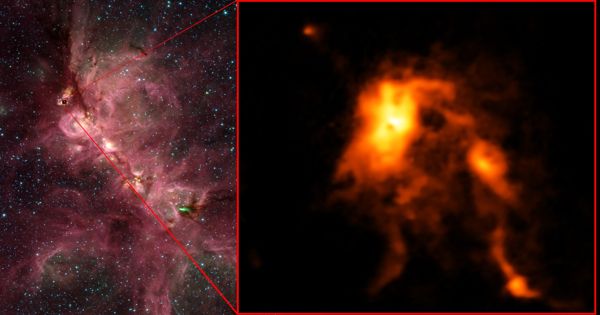CM Draconis is an eclipsing binary system located 47 light-years distant in the constellation Draco (the Dragon). This system consists of two eclipsing mid-M dwarfs of almost identical mass in a 1.27-day orbit. The system is made up of two almost similar red dwarf stars in the constellation Draco. The two stars orbit each other with a period of 1.27 days and a distance of 2.7 million kilometers (0.018 AU). The stars in CM Draconis, together with two stars in the triple system KOI 126, have the lightest masses and radii.
CM Draconis is a main-sequence character. It is not part of the Draco constellation outline, but it is inside the constellation’s boundaries. It is 48.44 light-years away from Earth. As a result, the system is crucial in evaluating stellar structure predictions for very low mass stars. According to these analyzes, models underpredict stellar radii by about 5%. This is due to the effects of the stars’ tremendous magnetic activity.
At least one of the system’s components is a flare star, and at least one is a BY Draconis variable, according to the system’s entry in the Combined General Catalogue of Variable Stars. GJ 630.1B, a white dwarf star 25.7 arcseconds distant, has the same proper motion as the CM Draconis stars and is thus a real companion star of the system. Given the system’s distance of 47 light-years, the separation between CM Draconis and GJ 630.1B must be at least 370 astronomical units.

Possible planetary system
CM Draconis’s color and type are red main-sequence stars, based on the star’s spectral classification of M4.5V C. Based on the spectral type, we can estimate that the star’s surface temperature is in the range of below 3,500K, according to Harvard University’s comments. The star’s parallax is stated as 67.34000, resulting in a computed distance to CM Draconis of 48.44 light-years or 14.85 parsecs from Earth.
From 1994 to 1999, the system was the focus of a dedicated search for transiting extrasolar planets in orbit around the double. In the end, the existence of all of the project’s transiting planet candidates was ruled out.
It has been proposed that an object in a circumbinary orbit around the two red dwarf stars exists based on fluctuations in the timing of the system’s eclipses. It was postulated in 2000 that a Jovian planet orbits the system with a period of 750–1050 days. A further investigation of timing differences did not support this putative planet, instead of implying the existence of a Jovian planet in an 18.5-year orbit or a more massive object further out.
A 2009 research found that the eclipse timings were indistinguishable from linear, albeit the binary stars do have a slight eccentricity, which may imply that they are being disrupted by an orbiting body, preventing the orbit from being totally circularised by tidal effects.
A huge planet or brown dwarf on an orbit of 50–200 days would satisfy the observational criteria: the demand for dynamical stability, the constraints imposed by the lack of observed timing variations, and the requirement that the object preserve the binary stars’ eccentricity.
















